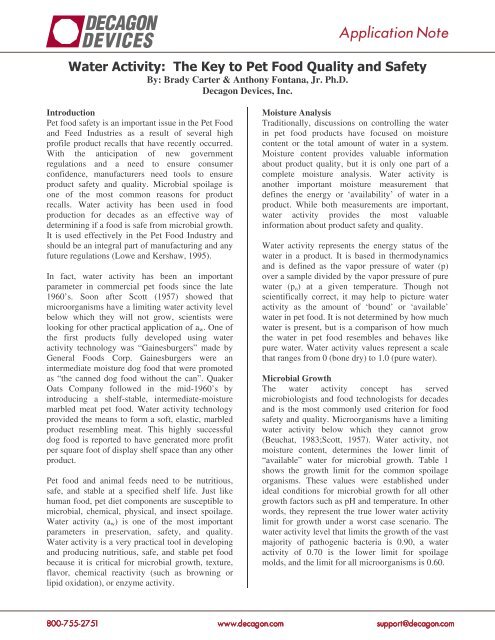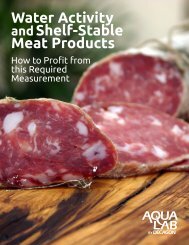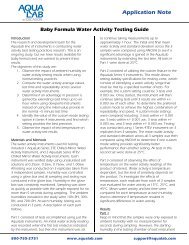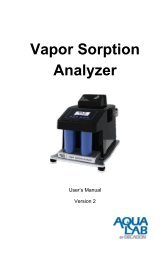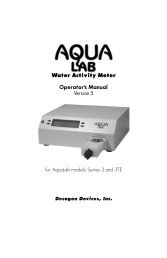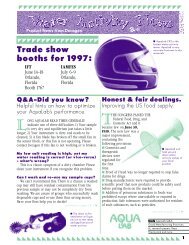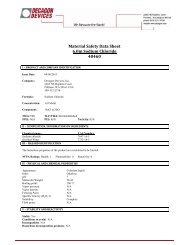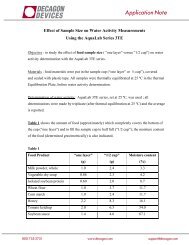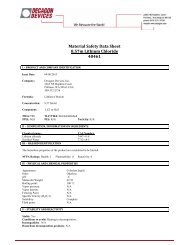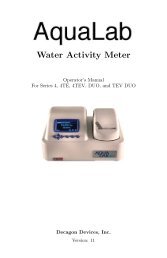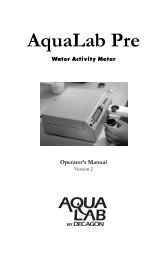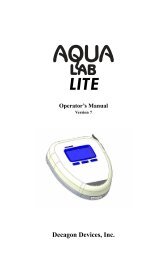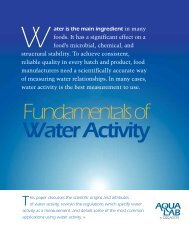13504-00 AN, Water Activity The Key to Pet Food Quality ... - AquaLab
13504-00 AN, Water Activity The Key to Pet Food Quality ... - AquaLab
13504-00 AN, Water Activity The Key to Pet Food Quality ... - AquaLab
Create successful ePaper yourself
Turn your PDF publications into a flip-book with our unique Google optimized e-Paper software.
6. ročník – PřírodopisOdpovědi:Téma: Prvoci, žahavce, ploštěnci, hlístiA- na V pobřeží, kterého kontinentu se nachází Velký bariérovýútes - AustrálieB- zapouzdřená larva tasemnice v mase skotu - boubelC- klidové stádium, při kterém se organismus zapouzdří do -cystyČ- části těla tasemnice - článkyD- jaký způsob života mají žahavci - dravýE- vztahy mezi živou a neživou přírodou se zabývá vědní oborEkologieF- děj, při kterém se přeměňuje oxid uhličitý a voda na glukosu akyslík se nazývá - fo<strong>to</strong>syntézaG- vyhledávač na internetu- googleH- červy s kulatým tělem - hlístiCH- hnědá řasa - chaluhaJ - období v roce, kdy se rozmnožuje trepka nepohlavně - jaroK- mořští živočichové mající vápenité schránky a tvořící útesykoráliL- kdo sestavil mikroskop - LeeuwenhoekM- ploštěnec, který se živí krví ovcí v játrech - mo<strong>to</strong>liceN- přisedlý žahavec, žijící ve sladké vodě - nezmarO - hermafrodit - obojetníkP - nervová soustava ploštěnců - provazcovitáR - hlíst parazitující u dětí o velikosti 1 cm - roup dětskýŘ – vodní rostliny - řasyS - sladkovodní dírkonožci - slunivkyŠ - 25 cm parazit člověka, psů, koček, který má kulaté tělo -škrkavkaT - cizopasník s plochým tělem - ploštěnciU - druh houby s plodnicí - ucháčV- z vajíčka přímo dospělý jedinec, jde o přímý…vývojW- anglicky voda - waterZ - chlorofyta - zelené řasyŽ - kmen živočichů, který loví kořist žahavými buňkami - žahavci
Table 2. <strong>Water</strong> activities of common pet food products as measured usingDecagon Devices’ <strong>AquaLab</strong> chilled mirror water activity instrument.Product <strong>Water</strong> <strong>Activity</strong> Moisture Content(% d.b.)Moist Canned <strong>Pet</strong> <strong>Food</strong> 1 0.994 79.6Moist Canned <strong>Pet</strong> <strong>Food</strong> 2 0.830 24.0Intermediate Moisture <strong>Pet</strong> <strong>Food</strong> 1 0.823 13.70Intermediate Moisture <strong>Pet</strong> <strong>Food</strong> 2 0.791 14.40Intermediate Moisture <strong>Pet</strong> <strong>Food</strong> 3 0.679 8.43Intermediate Moisture <strong>Pet</strong> <strong>Food</strong> 4 0.669 13.0Intermediate Moisture <strong>Pet</strong> <strong>Food</strong> 5 0.525 9.21Dry <strong>Pet</strong> <strong>Food</strong> 1 0.493 8.59Dry <strong>Pet</strong> <strong>Food</strong> 2 0.459 7.79Dry <strong>Pet</strong> <strong>Food</strong> 3 0.236 4.40handling, packaging and s<strong>to</strong>rage <strong>to</strong> maintain propertextural qualities.Because water activity is a measure of the energystatus of the water, differences in water activity arethe driving force for moisture migration. Bydefinition, water activity dictates that moisture willmigrate from a region of higher a w <strong>to</strong> a region oflower a w , but the rate of migration depends on manyfac<strong>to</strong>rs. Many pet foods are multi-componentproducts with heterogeneous regions. If theseregions are at different water activities, water willmigrate between the components until they reach anequilibrium water activity, regardless of theirmoisture contents (Brandt, 1996;Katz and Labuza,1981). For example, if two components of a multicomponentpet food product both have 15%moisture content but are different water activities,moisture will be exchanged, even though theirmoisture contents are the same. This moisturemigration could lead <strong>to</strong> textural or microbialspoilage problems.<strong>The</strong>re are a number of products on the market withmulti-textured characteristics that use wateractivity. <strong>The</strong>se products combine a hard, dry-bakedpet food and a soft, moist pet food. <strong>The</strong> hard, drycomponent has the advantage of teeth cleaning, butis less palatable than a soft, moist food. <strong>The</strong> soft,moist component may be highly palatable, but lacksthe abrasive teeth cleaning property. When the twocomponents are mixed, they equilibrate <strong>to</strong> acommon equilibrium water activity during s<strong>to</strong>rage.This equilibrium a w must allow the dry component<strong>to</strong> remain hard and crunchy while leaving the softcomponent moist and tenderMeasurement of <strong>Water</strong><strong>Activity</strong><strong>Water</strong> activity is measuredby equilibrating the liquidphase water in the samplewith the vapor phase waterin the headspace of a closedchamber and measuring thevapor pressure of theheadspace. New instrumenttechnologies have vastlyimproved speed, accuracyand reliability ofmeasurements. Twodifferent types of wateractivity instruments arecommercially available. Oneuses chilled mirror dewpoint technology while theother utilizes relative humidity sensors that changeelectrical resistance or capacitance; each hasadvantages and disadvantages. <strong>The</strong> methods vary inaccuracy, repeatability, speed of measurement,stability in calibration, linearity, and convenience ofuse.In a chilled mirror dewpoint system, a sample isplaced in a sample cup which is then sealed againsta sensor block. Inside the sensor block is adewpoint sensor, an infrared thermometer, and afan. <strong>The</strong> dewpoint sensor measures the dewpointtemperature of the air and the infrared thermometermeasures the sample temperature. From thesemeasurements, the relative humidity of theheadspace is computed as the ratio of dewpointtemperature saturation vapor pressure <strong>to</strong> saturationvapor pressure at the sample temperature. When thewater activity of the sample and the relativehumidity of the air are in equilibrium, themeasurement of the headspace humidity gives thewater activity of the sample. <strong>The</strong> fan is <strong>to</strong> speedequilibrium and <strong>to</strong> control the boundary layerconductance of the dewpoint sensor.<strong>The</strong> major advantages of the chilled mirrordewpoint method are speed and accuracy. Chilledmirror dewpoint is a primary approach <strong>to</strong>measurement of relative humidity based onfundamental thermodynamic principles. Chilledmirror instruments make accurate (±0.<strong>00</strong>3a w )measurements in less than 5 minutes. Since themeasurement is based on temperaturedetermination, calibration is unnecessary, butrunning a standard salt solution checks properfunctioning of the instrument. If there is a problem,
the mirror is easily accessible and can be cleaned ina few minutes. For some applications, fast readingsallow manufacturers <strong>to</strong> perform at-line moni<strong>to</strong>ringof a product’s water activity.Other water activity instruments use resistance orcapacitance sensors <strong>to</strong> measure relative humidity.<strong>The</strong>se sensors are made from a hygroscopicpolymer and associated circuitry that gives a signalrelative <strong>to</strong> the equilibrium relative humidity (ERH).Commercially available instruments measure overthe entire a w range with an accuracy of ±0.015a w .Since these instruments relate an electrical signal <strong>to</strong>relative humidity, the sensor must be calibratedwith known salt standards. In addition, the ERH isequal <strong>to</strong> the sample water activity only as long asthe sample and sensor temperatures are the same.Accurate measurements require good temperaturecontrol or measurement. Advantages of capacitancesensors include simple design and inexpensiveimplementation.Conclusion<strong>Water</strong> activity is an effective <strong>to</strong>ol for maintainingthe stability, quality, and safety of pet food. Inaddition, in the intermediate moisture region, whichincludes a majority of the pet food, changes inmoisture content that are undetectable due <strong>to</strong> thelimited accuracy of moisture content analyses canresult in large changes in water activity andconsequently, changes in stability. This can bedisconcerting when pet food is dried <strong>to</strong> a moisturecontent specification and stability changes suddenlyoccur even though a moisture content change is notdetected. <strong>The</strong>se stability changes can be predicted ifa water activity specification is used. <strong>Water</strong> activityis a fast, inexpensive, and accurate way of assuringthe quality and safety of pet food. It can easily beincorporated by any production facility or qualitycontrol labora<strong>to</strong>ry.<strong>The</strong> pet food and feed industries have long usedwater activity <strong>to</strong> create novel products and predictshelf life, safety, and quality. Determination ofwater activity during manufacture allows tightcontrol of pet foods and feedstuffs found <strong>to</strong> be athigh risk for deterioration. Without the use of wateractivity, the pet food industry would have a hardtime developing novel new products or producingnutritious, high quality, stable food.Reference ListBeuchat,L.R. 1983. Influence of water activity on growth, metabolic activities, and survival of yeasts and molds. J <strong>Food</strong>Prot 46:135-141,150.Brandt,L. 1996. Bound for success. Controlling water activity gives technologists the edge in developing safe, shelf-stablefoods. <strong>Food</strong> Formulating 2:41-48.Katz,E.E. and T.P.Labuza. 1981. Effect of water activity on the sensory crispness and mechanical deformation of snackfood products. J <strong>Food</strong> Sci 46:403-409.Lowe,J.A. and S.J.Kershaw. 1995. <strong>Water</strong> activity-moisture content relationship as a predictive indica<strong>to</strong>r for control ofspoilage in commercial pet diet components. Animal Feed Science and Technology 56:187-194.Scott,W.J. 1957. <strong>Water</strong> relations of food spoilage microorganisms. Adv <strong>Food</strong> Res 7:83-127.()*$%& *$+%$,% !&-!$$!+$# !"#$%& % '''#$%& %


